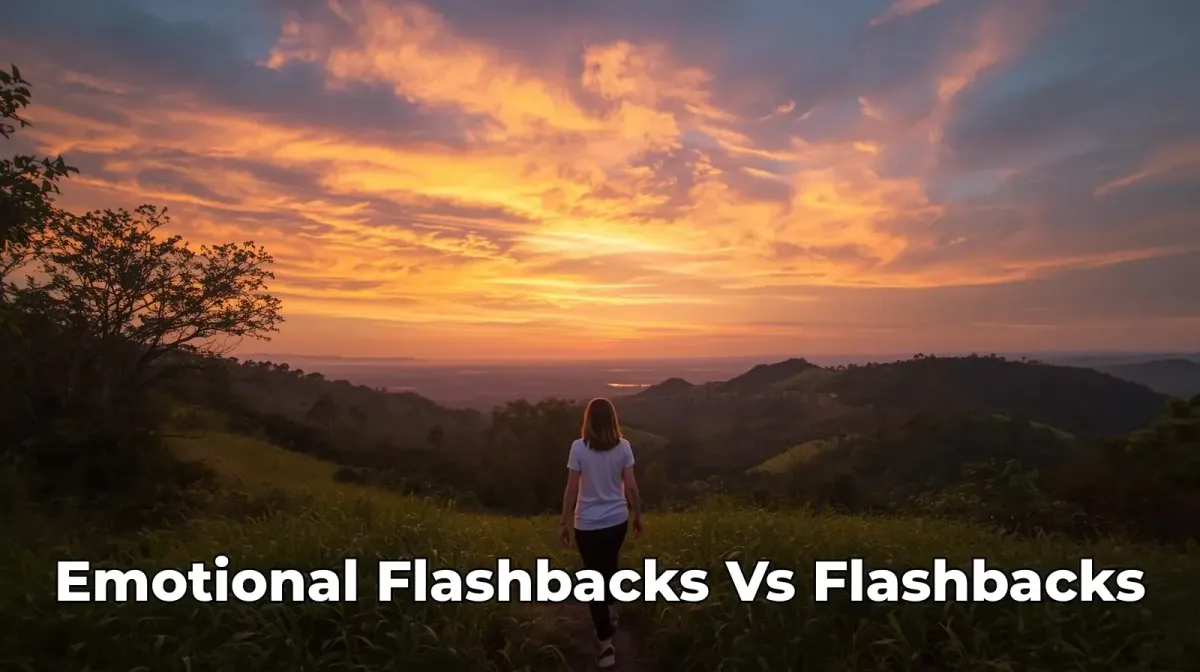Peter Paul Parker's Official Website
Articles And Guidance

Emotional Flashbacks vs Flashbacks: Clear Terms
Words matter when you’re overwhelmed. “Flashback” and “emotional flashback” are used online in different ways. This guide keeps the language clear and kind. You’ll learn the difference in simple terms, spot early signs, and use a short grounding sequence you can rely on when waves hit.
For a wider healing map, visit Emotional Healing & Emotional Trauma: The Complete Guide.
What a clinical flashback means (plain English)
A flashback is a brief episode where aspects of a past trauma feel as if they’re happening now.
It can be images, sounds, smells, body sensations, or strong emotions.
Time feels strange. The body reacts fast. You might freeze, fight, or flee.
It passes, but it’s intense. Afterwards you may feel shaky, tired, or confused.
If this is your experience, you are not “being dramatic.” Your nervous system is protecting you, just a little too strongly.
What people mean by “emotional flashback”
Online, many use “emotional flashback” to describe a sudden surge of fear, shame, grief, rage, or numbness without clear images or memories.
It can be a younger part of you seeking safety. It can be the body remembering more than the mind.
The term isn’t a formal diagnosis, but it helps people name a real experience.
Use the language that helps you feel understood and cared for.
If the term confuses people around you, try: “I’m having a strong body-memory response. I need a minute to ground.”
What to Do in the First 60 Seconds
Feel your feet. Lengthen your exhale.
Name three present-moment facts you can see or hear.
Say one sentence of self-respect: “I can pause.”
Return to shadow work only when steady.
Then try:
People-Pleasing and Fawn-Aware Boundaries
Empath Shadow Work: Safety-First Map
Early signs and common triggers
Sudden tight chest, hollow belly, or heat in the face.
Thoughts speed up. Or go blank.
Urge to hide, appease, argue, or run.
Sharp sensitivity to tone, silence, or facial expressions.
Triggers: criticism, perceived rejection, loud noise, bright light, strong smells, crowds, authority settings, or intimate conversations.
Learning your early signs helps you intervene sooner. Map them against your window using Window of Tolerance: HSP Quick Map.
A 90-second grounding sequence (use anywhere)
Step 1 — Name & normalise (10s).
Quietly say: “Wave. Not danger. I’m safe enough right now.”
Step 2 — Anchor the body (20s).
Press feet to the floor. Feel heel-to-toe. Micro-bend knees.
Step 3 — Soften the jaw and exhale (30s).
Unclench teeth. Lips closed. Slow nasal exhale a little longer than the inhale (for example, 4-in, 6-out). Repeat three cycles. Try patterns from Vagus-Nerve Breathing Patterns for HSPs.
Step 4 — Orient gently (20s).
Name 3 things you can see. 2 things you can touch. 1 kind thing you can tell yourself.
Step 5 — Micro-move (10s).
Roll shoulders down-back. Open hands. Blink slowly twice.
If you need a quicker reset, use the tools in 2-Minute Body Resets (Save-and-Use Toolkit) for HSPs.
Aftercare: close the loop kindly
Sip water or rinse your face.
Shake out hands and arms for 10–20 seconds.
Tiny nourishment: a few nuts, a banana, or a warm drink.
Note one cue you spotted before the wave peaked. That’s gold for next time.
If you have space later, a short, gentle page of writing can help. See Expressive Writing for Shadow Work.
When waves keep coming (build steady habits)
Daily micro-regulation beats occasional big sessions.
Morning rhythm reduces evening spill-over. Try Morning Rituals for HSPs: Start Calm.
Overwhelm buffers give you a plan on hard days: Overwhelm Recovery Routines for HSPs.
If pain or fear of sensations is part of the picture, learn a kinder way to notice with Somatic Tracking for HSPs: Build Body Trust.
When to seek extra support
Flashbacks are frequent and you feel unsafe.
You’re using alcohol or substances to cope.
Sleep is collapsing, or nightmares won’t ease.
You feel stuck in shame or hopelessness.
You’re not sure what’s happening in your body and it scares you.
Ask your GP about local options. Bring notes on frequency, triggers, and what helps. You deserve steady, compassionate care.
FAQs
1) Do I have to use the term “emotional flashback”?
No. Use the words that help you feel understood. You could simply say “strong body-memory” or “overwhelm wave.”
2) Why do I freeze instead of cry or shout?
Freeze is a protective reflex. It often means your system is trying to keep you safe with the least risk. Ground first, then move gently.
3) Can breathwork make it worse?
Too fast or too long can spike symptoms. Keep it short and slow, with longer exhales. If it agitates you, switch to orienting and micro-movement.
4) Should I process the memory during a wave?
No. Stabilise first. Process later when you feel safer and more resourced.
5) How do I explain this at work or with family?
Keep it simple: “Sometimes my body overreacts to stress. If I go quiet, I’m grounding. I’ll rejoin soon.” Share one thing they can do, like lower voices or pause the conversation.
In Conclusion
Clinical flashbacks are reliving moments; “emotional flashbacks” are intense feeling waves without clear images. Both are real and valid experiences. Your job is not to power through, but to ground, orient, and close gently. Small, repeatable habits rebuild trust so waves pass sooner and life feels steadier again.
For deeper, steady support, explore Emotional Healing & Emotional Trauma: The Complete Guide and 2-Minute Body Resets (Save-and-Use Toolkit) for HSPs.
Next steps
You don’t have to do this alone. If spiritual overwhelm keeps knocking you out of your window—or you feel lost between big openings and everyday life—these two gentle paths give you practical support for exactly what we’ve covered:
Free Soul Reconnection Call — A calm, one-to-one space to settle your system, set spiritual boundaries, and design tiny, repeatable rituals so your practice feels safe, embodied and sustainable.
Dream Method Pathway — A self-paced, 5-step map (Discover → Realise → Embrace → Actualise → Master) to heal old loops, build daily regulation, and integrate spirituality into a stable, meaningful life.

Choose the route that feels kindest today. Both are designed to help highly sensitive people grow spiritually with steadiness and self-trust—gently, steadily, and for real change.
I look forward to connecting with you in my next post.
Until then, be well and keep shining.
Peter. :)
Feeling Spiritually Lost? 🢂
Copyright Peter Paul Parker 2023 <<< ✺✺✺✺✺✺✺✺✺✺✺✺✺✺✺✺✺✺✺✺✺ >>> Terms And Conditions - >>> Privacy - Linked In - YouTube - Facebook -
